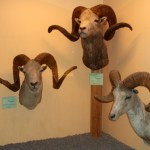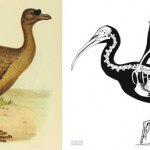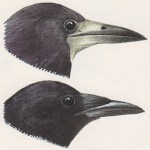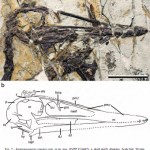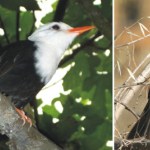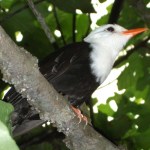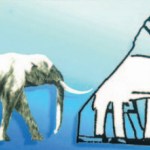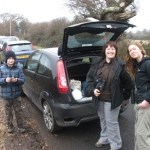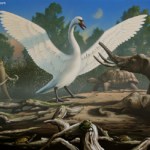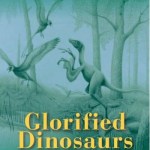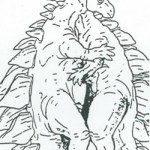
Back in May 2007 I wrote a few articles about the world's wild sheep (Welcome.... to the world of sheep and Return.... to the world of sheep). If you're here for the dinosaurs, pterosaurs, pygmy mammoths and lake monster photos, you might regard wild sheep as pretty boring animals. But they're clearly not - they're incredible and spectacular in appearance, often surprisingly large, and they live wild lives in beautiful, wild locations. And they're highly popular, and the source of great fascination, among a great many people interested in animals - those 2007 articles have been good at…
It seems wrong not to talk, at least briefly, about the latest lake monster picture that's doing the rounds. It's a poor-quality mobile phone photo of a humped object, taken in England's Lake Windermere by Tom Pickles while he was kayaking as part of a team-building exercise. Here it is... (or, rather, here is the uncropped image... read on)...
Pickles described the object as "a giant dark brown snake with humps measuring three car lengths", and regarded it as somewhat seal-like in skin texture but with a "completely abnormal" shape.
Apparently, it moved rapidly, with an undulating motion.…
Time to finish one of those long-running series of Tet Zoo articles: at last, the long-awaited, much anticipated third and final instalment in the series on the clubs, spurs, spikes and claws present on the hands of numerous neornithine bird species. If you haven't done so already, do check out the previous parts here (on hand claws in general, and carpal spurs and knobs in waterfowl) and here (on carpal spurs in charadriiforms).
Those previous instalments looked at claws (widely present in modern birds: far from unique to the Hoatzin Opisthocomus hoazin) and at keratin-sheathed bony knobs…
I love turkeys, and here I specifically mean the so-called Wild turkey Meleagris gallopavo and its domestic variants, not the Ocellated turkey M. ocellata (though - don't get me wrong, Ocellated turkeys are great too). Herewith a brief look into the world of turkeys (part of it recycled from Tet Zoo ver 1)... involving a brief excursion on motmots and rooks. I was going to finish up on the whole pterosaur reproduction thing, but I can't. I'll explain why soon enough. [Composite below incorporates images from wikipedia and an original at far right].
Like so many birds, turkeys are…
We know all too little about the biology and behaviour of the pterosaurs, the amazing, often bizarre flying reptiles of the Mesozoic Era. Most of our ideas - about feeding behaviour, locomotion, physiology and social and sexual behaviour - are inferences based on bones, or inferences based on interpretations of the bones. A new paper - published just a few weeks ago by Junchang Lü, David Unwin and colleagues in the journal Science - describes what might be one of the most interesting pterosaur fossils yet discovered, and arguably one of the most significant in terms of what it tell us about…
I've just heard the tragic and saddening news that ornithologist Bradley Livezey died yesterday morning (Tuesday 8th February, 2011) following a car crash. It seems that his car lost traction due to snow and ice on the road surface and then collided with another vehicle. Brad was 56. I never met him, but regarded him as a very friendly and co-operative correspondent.
Brad was a leading ornithologist, based at the Carnegie Museum of Natural History. After receiving a bachelor's degree at Oregon State University in 1976, he was awarded a master of science degree at the University of Wisconsin-…
Borrowed from here on David's Really Interesting Pages (and used with permission: thanks David). A sort of homage to this article from last month.
In terms of its zoological diversity, Europe is the best known continent on the planet. Indeed it's generally assumed that just about all of Europe's macrofauna has, by now, been discovered. While that's mostly true, it seems that at least a few species - so called 'cryptic species' - have been missed, mostly because they're extremely similar to their close relatives.
Here, I want to look briefly at new discoveries made concerning the diversity of European microbats [composite above shows, clockwise from top left: Pipistrellus pipistrellus, Plecotus auritus, Pl. austriacus and Myotis…
One of my long-running plans on Tet Zoo has been to review passerine phylogeny. After decades of people saying that oscine passerines are (except larks and corvids) far too alike for anyone to construct a sensible phylogeny, a flurry of (mostly molecular) studies have meant that - as I like to say - the passerine tree is finally coming together. Alas, I'm nowhere near able to review current hypotheses of passerine evolution in depth (and didn't I say something recently about not starting any new major Tet Zoo projects?).
Well done to those of you who correctly identified the 'mystery' bird…
Please identify. If possible, make it more interesting by saying something about the animal's behaviour, ecology and/or phylogenetic position (believe me, there is plenty to say). As usual, a smug sense of self-satisfaction to the winner.
I really enjoyed the long and involved debate that followed my article on the small elephant depicted on the wall of Rekhmire's tomb. Thank you to (just about) everyone who contributed. As I tried to make clear in the actual article, we'll likely never know the truth of the matter, and this whole exercise should be seen as a bit of fun speculation [image below © Alessando Mangione and Marco Masseti].
Those of you who argued that the elephant could likely be stylized, or an inaccurate rendition of either an adult or juvenile Asian elephant Elephas maximus, could well be right. But, equally…
Welcome to part II of my musings on the 2010 blogging year. You'll need to have read the first part to make sense of it. The article you're reading now is extraordinarily long and I'd normally break up a piece of this length into two, three or even more separate articles. This year I want to get the birthday stuff out of the way as quickly as possible, however, so bear with me. Hey, you don't HAVE to read any of it. And so, off we go...
One of the bigger Tet Zoo-relevant issues of the year was the publication in September of Tetrapod Zoology Book One (Naish 2010a). Already I've seen several…
Today, my friends, is January 21st 2011. Do you know what this means? It means (drumroll)... that Tet Zoo is five years old today. Wow. Five years. With apologies to those who've heard the story before, things started in 2006 over at blogspot, and in 2007 Tet Zoo ver 2 kicked off here on ScienceBlogs. So: happy birthday Tet Zoo!
The fact that I've now been blogging about hardcore zoology for five years is a little scary; it makes me worried that things here might have become stale or blasé. To be honest, if that's so I haven't noticed and, anyway, my motivations for blogging are almost…
One of the things that came up in the many comments appended to the article on Bob's painting of extinct Maltese animals was the famous Egyptian tomb painting of the 'pygmy mammoth'. You're likely already familiar with this (now well known) case: here's the image, as it appears on the beautifully decorated tomb wall of Rekhmire, 'Governor of the Town' of Thebes, and vizier of Egypt during the reigns of Tuthmose III and Amenhotep II (c. 1479 to 1401 BCE) during the XVIII dynasty...
In 1994, Baruch Rosen published a brief article in Nature in which he drew attention to the small, tusked,…
The big buzz here in Hampshire (southern England) at the moment is the recent arrival of a White-tailed eagle Haliaeetus albicilla. This magnificent raptor - it can have a wingspan of 2.4 m and is one of the biggest eagles in the world - is historically extinct in England, but individuals still appear here on occasion [image of the Hampshire bird shown here by Darren Crain].
A member of the 'sea eagle' clade Haliaeetus, the White-tailed eagle appears to be the sister-species of North America's only sea eagle, the Bald eagle H. leucocephalus (Wink et al. 1996, Lerner & Mindell 2005).…
It's well known that the islands of the Mediterranean were formerly home to an assortment of island endemics, all of which are now extinct. Most of the best known ones are mammals like pygmy elephants, pygmy hippos, pygmy megacerine deer and giant dormice, but there were also large birds, tortoises and lizards. My excellent friend Bob Nicholls of www.paleocreations.com has been kind enough to share this wonderful piece of art, featuring extinct and extant animals of Pleistocene Malta (close-ups below the fold). It's used with permission and is © Robert Nicholls.
One thing I particularly…
I read a lot of books in 2010, and mostly enjoyed all of them. Among my favourites was Luis Chiappe's Glorified Dinosaurs: The Origin and Early Evolution of Birds, and in the lengthy review article below (currently in press for Historical Biology) you can find what I thought of it. Note that Glorified Dinosaurs is not especially new (it appeared in 2007): it typically takes a few years for lengthy written reviews of large books to see completion (or, ha, it does in my case anyway).
One more thing to note: some of what I say here (e.g., about the relationship between birds and other…
Time to wrap up on the SJG special - make sure you see part I and part II first. Wow, I never thought I'd end up writing three long articles on this series of papers (hmm, a familiar theme). In the previous articles we looked at stegosaur systematics, and at Heinrich Mallison's work on the ranges of movement and posture of Kentrosaurus. This time round, we look at the papers that discuss preserved soft tissues, the possible role of the plates, and on feeding behaviour. Oh, and we finish up by looking at some other stuff too...
As I said before, the papers I'm discussing here appeared last…
If you read the previous article on stegosaurs you'll know that a collection of papers devoted to examination of this fascinating group appeared last year (2010) in a special issue of Swiss Journal of Geosciences (SJG from hereon). These papers resulted from a meeting held at the Sauriermuseum Aathal, Switzerland, in June 2009 (Billon-Bruyat & Marty 2010). Last time round, we looked at the papers on stegosaur systematics and diversity. Here, we begin a look at the remaining papers: they cover such subjects as athleticism and posture, possible feeding behaviour, soft tissue preservation…
Whales are the most beautiful, perfect animals in the whole history of life. Shiny and flawless like pristine boiled eggs, they exist in perfect harmony with their environment, refuse to inflict needless suffering on other forms of life, and never suffer from disease or illness. Ha ha, just kidding! Check out these photos of a Bowhead Balaena mysticetus skeleton I encountered recently (IRSNB, Brussels). What can I say, other than "Ouch!".
This first photo shows the base of the whale's tail in left lateral view (the end of the tail is to the far right).
And here's the same region but seen…
